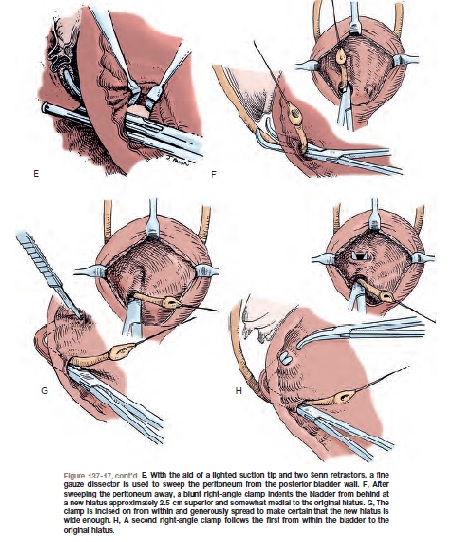توضیحات
Politano-Leadbetter Technique
The principle behind this technique, which was originally described
by Politano and Leadbetter (1958), is to bring the ureter in through
a new hiatus superior to the original insertion. A submucosal tunnel
is created in the direction of the trigone, medial to the original
orifice. The advantage of this technique is that a long tunnel can be
created, which is valuable in the higher grades of reflux. This antireflux
mechanism can be further supported by a psoas hitch.
Technique
After completion of the ureteral mobilization intravesically, the
location of new hiatus is selected in a straight line superior to the
original orifice (Fig. 137-17). With the bladder open and the lateral
walls retracted, the inexperienced surgeon might be inclined to
position the new hiatus too laterally on the posterior wall. Once
the bladder is closed and full, the ureter enters on the anterolateral
wall and then hooks back posteriorly toward the trigone, creating
the classic “hooking,” which is an important cause for postoperative
ureteral obstruction. In the original description of the Politano-
Leadbetter technique, the new hiatus was created blindly by passing
a right-angle clamp from the original hiatus behind the bladder to
Paquin described this combined extravesical/intravesical technique
in 1959 (Paquin, 1959). The new ureteral hiatus is created from
outside the bladder, thus avoiding the difficulties associated with
this maneuver in the Politano-Leadbetter technique. As with most
of the other open techniques, a success rate greater than 95% for
primary VUR is achieved with this method (Woodard and Keats,
1973).
The ureter in the Paquin technique can be approached extravesically
(see Extravesical Procedures) before opening the bladder. A
right-angle clamp is applied at the UVJ, the ureter is divided, and a
3-0 polyglactin suture is used to suture ligate the original hiatus.
The bladder is then opened in the midline, and a new hiatus is
created, located cephalad to the prior position. The peritoneum is
carefully cleared off the back wall of the bladder at the site of the
new hiatus. A right-angle clamp is passed from inside the bladder
under direct vision, and one end of a 5-mm Penrose drain is pulled
into the bladder. A mosquito snap is applied to the Penrose drain,
which acts as a holder and facilitates the creation of the submucosal
tunnel. The mucosa is dissected off the detrusor circumferentially
at the new hiatus. The length of the submucosal tunnel is governed
by the diameter of the ureter, and a 5 : 1 ratio is usually achievable.
In more complex cases a psoas hitch may be required to achieve a
longer tunnel length. The tunnel is developed by carefully lifting
the mucosa off the detrusor using tenotomy scissors. Countertraction
on the mucosa is helpful, especially in cases that must be
redone and when the bladder wall is trabeculated. Once the tunnel
is developed the remainder of the reimplants is similar to the
Politano-Leadbetter procedure.
The modified Paquin technique is particularly suited for dilated
ureters and complex (El-Sherbiny et al, 2002) and failed reimplants
(Mesrobian et al, 1985) because of the versatility offered by the
combined extravesical/intravesical approach to the ureter and the
ability to achieve longer submucosal tunnel lengths.

